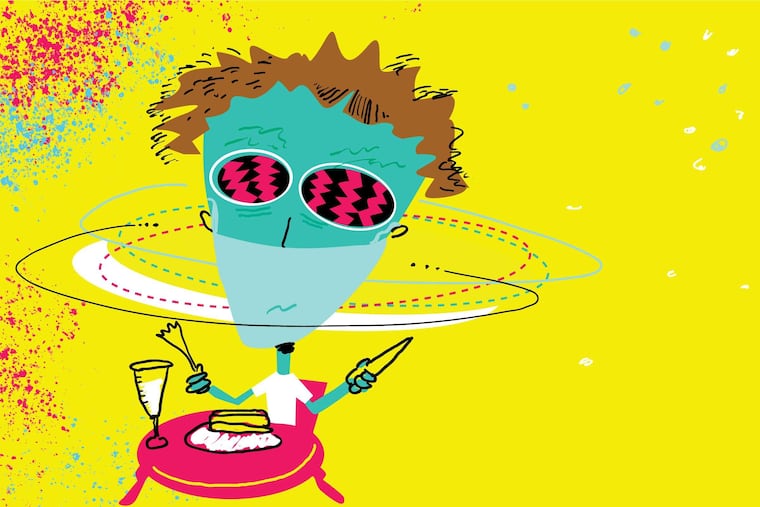As restaurants return, anxiety may ease | Perspective
"For so long, restaurants had been a source of deep unease. I had to teach my hyper-active brain to stop envisioning catastrophe."

My homework assignment was to eat breakfast at Bob’s Diner.
There was more: a smorgasbord of strategies including a deep-breathing exercise (hand on the roiling belly; slow exhale to the count of four), a distraction (every section of a thick Sunday newspaper) and, if bad ramped up to worse, a wallet-sized card with affirmations I could read while hyperventilating in the diner’s stamp-sized bathroom.
I can be anxious and still do this. Restaurants are warm and safe. No one has ever died of a panic attack. Not yet, I thought, as I tucked the pink card behind my driver’s license.
I’d been suffering anxiety attacks in public venues — movie theaters, museums, jammed department stores — for more than five years. It started at Alexis, a Greek restaurant in Portland, Oregon, when I was 25; somewhere between the chilled retsina and the flaming saganaki, my palms turned slick and my throat tightened to a narrow straw.
The room wobbled. My vision blurred. Static in my head crackled louder than the conversation. My heart jabbered away inside my chest, a chant of dread: Get out of here, or faint, or die. I chose the former. Outside, on the corner of West Burnside Street, all I felt was the cold sweat of relief.
After that, I had more panic attacks: over boysenberry pancakes at Zell’s Cafe; while clinking mugs of handcrafted ruby ale at McMenamins. Even a whiff of griddled masa from a food truck could kick-start my sympathetic nervous system and send me hurtling toward full-tilt panic.
I developed a library of excuses — "Let’s cook at home, it’s cozier … I had a big lunch … sorry, I’m broke” — and begged my sweetheart to mark my birthday with a picnic.
But then we moved to Philly, my home turf. It was 1999, and the city had morphed during my 10-year West Coast sojourn. Restaurants were flourishing: global cuisine plate-to-plate with Philly stalwarts. New friends suggested meeting at Porcini after Spanish class. My parents offered to toast our anniversary with a splurge at La Famiglia. An editor wanted to talk about story ideas over lunch at Marathon Grill.
I demurred. Or I went, then sat there, tense and nauseated, nudging food around my plate. I asked for take-home boxes. I said I wasn’t hungry. Finally, my fingers quivering on the phone, I called the anxiety disorders center at the University of Pennsylvania and found a cognitive behavioral therapist who promised she could help me learn to eat in restaurants again.
Start small, she counseled: not a three-hour Morimoto extravaganza, but a low-stakes visit, with my partner, to a breakfast spot within walking distance of our home.
We nabbed a two-top at Bob’s before the post-church rush. I sipped my decaf from a chunky off-white mug. We passed sections of the paper back and forth. And though I choked down only half a buttermilk pancake, it was something, a tiny victory that gave me the confidence to inch ahead.
For so long, restaurants had been a source of deep unease. I had to teach my hyperactive brain to stop envisioning catastrophe and stay anchored in the sensory lushness of it all — chilled knob of butter on a tiny plate, lemony whiff of pinot gris, baguette crumbs drifting to the linen napkin in my lap.
It took 12 sessions of therapy until I could enter a restaurant without measuring the distance from my table to the exit, to the bathroom, to the nearest trash can, just in case. It took longer until I could enter with anything like joy.
Meantime, the Philly food scene buzzed: new BYOBs in Passyunk and Fishtown; the Safran/Turner mini-empire in the Gayborhood. Hummuserias. Poke joints. Ramen simmering on every other corner. I took my mom to Jamonera for her birthday. We marked my daughter’s middle-school graduation with a sushi lunch at Pod. Occasionally, I needed to glance at the old mantras: No one has ever died from a panic attack. Restaurants are warm and safe. I can be anxious and still do this.
Now, people are dying — from police violence, from COVID-19 — and anxiety is everywhere. Many restaurants remain closed, at least to sit-down dining, and no one knows exactly how or if they will return. Scores of cooks and servers, sommeliers and maitre d’s , remain out of work. Some eateries that were limping by on take-out and delivery had their operations curtailed due to last week’s curfews and protests against police brutality. Others are boarded up for good.
In the throes of panic, I never thought I’d say this, but … I miss them. Restaurants are paradoxes: realms where the most intimate moments (arguments, proposals, tête a têtes) happen in full public view. Where someone can perch hip-to-hip with strangers who, by night’s end, are not so strange. They are — or used to be, pre-COVID — places to banter, flirt, negotiate, and use two forks to share one dense wedge of chocolate cake.
For a city, restaurants mean revenue, employment, culinary adventure, cultural delight. For me, they are something else: the places where, for five pained years, I feared to go. The venues where I faced my shakiest, most vulnerable human self. And where, amid the hum of other humans, I returned, to heal.